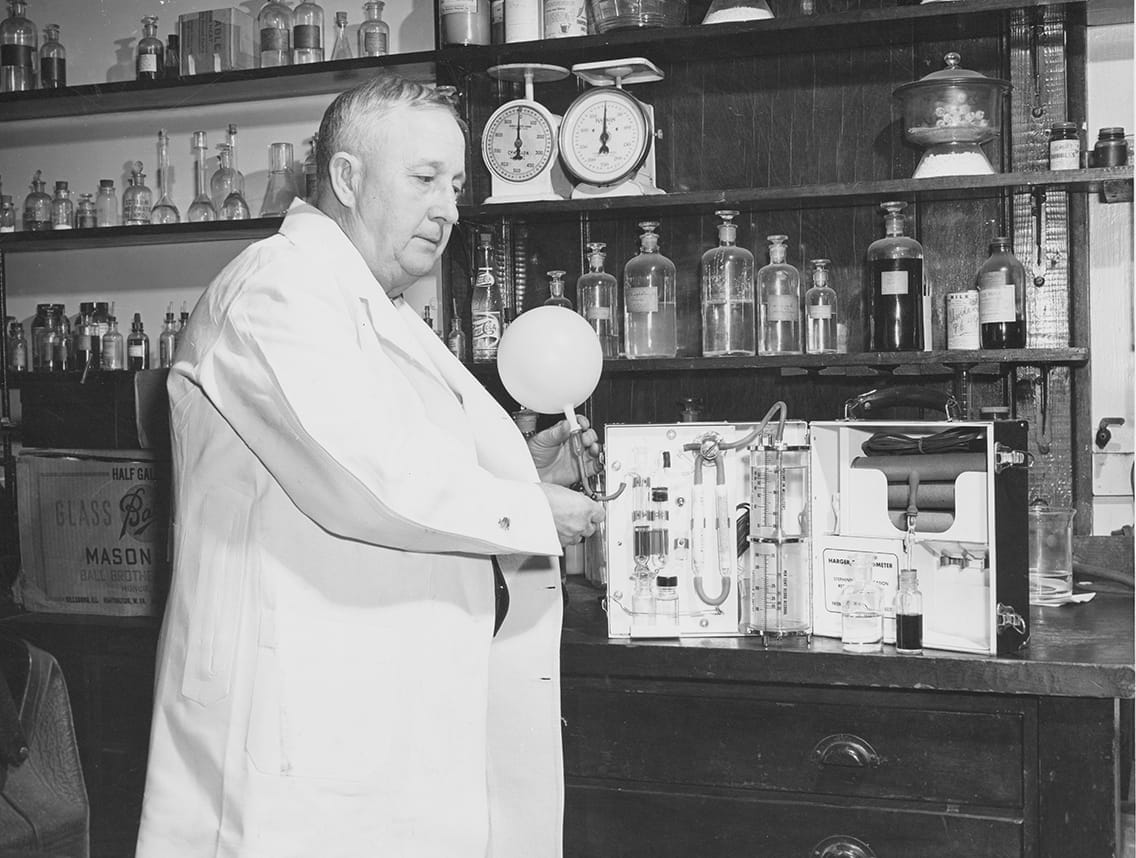Sober Analysis

Rolla N. Harger, MD, former chair of the Department of Biochemistry, earned a patent for the Drunkometer in 1936. It was a forerunner of the breathalyzer.
Matthew Harris Nov 11, 2020
AS WE MOVE into the holidays, it’s tempting to celebrate with an adult beverage—or a few. People who make the unfortunate choice to drink and drive put lives at risk. They also run the risk of being pulled over and putting their lips around a breathalyzer.
Few people know, however, that it was a biochemist at Indiana University School of Medicine who—more than 80 years ago—paved the way for what is now a staple tool in a field sobriety test.
Yes, it was Rolla N. Harger, MD, who in 1931 invented what for a time was the leading method for measuring blood-alcohol content. It was appropriately dubbed the Drunkometer.
Harger, who served on the IU School of Medicine faculty from 1922 to 1960, was inspired after another pathologist mentioned the idea. He spent four years developing the tool which he unveiled at a meeting of the American Chemical Society. Some peers scoffed. It was as big as a suitcase. And it relied on a birthday decoration to collect a sample.
But the Drunkometer operated simply. A suspect blew into a balloon and their breath mixed with a chemical solution which, in the presence of alcohol, changed color. The darker the shade, the higher the concentration. Blood-alcohol level was estimated using a simple formula. By 1936, the device won its patent, coming at a time when Prohibition was receding and driving was a larger part of daily life.
Its field debut, however, took place amid tragedy. On New Year’s Eve 1938, a drunk driver plowed through a trolley zone in Indianapolis, hitting several pedestrians. One was a woman shielding her baby, who did not survive.
The driver was arrested several blocks away. Police called Harger to the city jail to administer a test. It wasn’t easy. The driver refused to blow up the balloon. Two officers held her in a chair as the pathologist slowly used suction to pick up breath from her nose. The result was obvious. “She was plenty drunk,” Harger told The Indianapolis Star in 1977.
By the late 1940s, almost 80 cities across the country owned a Drunkometer. Yet Harger never profited. Instead, he turned his patents over to the Indiana University Foundation, a move he thought would remove self-interest as a doubt surrounding his views. “And I didn’t think anybody was going to make a whole lot of money out of it,” he added.
Harger, who chaired the Department of Biochemistry for 23 years, became a staunch advocate for laws regarding drinking and driving. He served on a National Safety Council subcommittee that drafted model legislation setting limits for blood-alcohol among motorists. Harger also acted as an expert witness at trials across the country.
In 1948, he taught breath alcohol testing with Robert F. Borkenstein, a professor in the Department of Police Administration who was a lab technician with the Indiana State Police. By 1954, Borkenstein would invent the Drunkometer’s more famous upgrade—the breathalyzer.
But with such a keen interest in sobriety while driving, you might ask if Harger was a teetotaler? Not so. He was known to indulge in the occasional Old Fashioned.
“I take a little,” he would tell the Star, “in the interest of science.”
Matthew Harris
Matthew Harris is a communications specialist in the Office of Gift Development. Before joining the School of Medicine in 2015, he was a reporter at newspapers in Pennsylvania, Arkansas, and Louisiana. He currently lives in Indianapolis with his wife and two basset hounds.